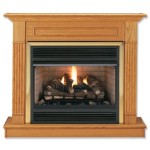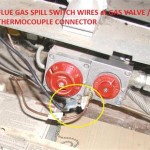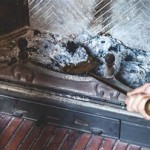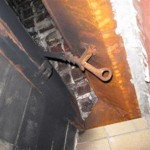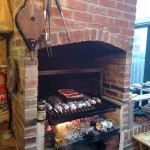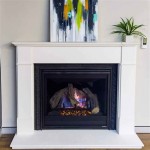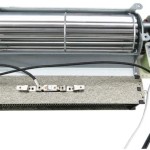How to Install a Propane Gas Line for a Fireplace
Installing a propane gas line for a fireplace is a significant undertaking that requires careful planning, adherence to safety regulations, and a reasonable level of plumbing and gas fitting experience. This article provides a comprehensive guide to the process. However, it is crucial to emphasize that working with propane gas can be dangerous, and any errors could lead to gas leaks, fires, or explosions. If uncertainty exists at any point, consulting a qualified and licensed gas fitter or plumber is highly recommended. Local building codes and regulations always supersede any general guidance provided here and must be followed meticulously.
Before embarking on the installation, thorough planning is essential. This includes determining the fireplace's BTU (British Thermal Unit) requirements, selecting the appropriate pipe size, and obtaining the necessary permits. Overlooking any of these preliminary steps can lead to costly rework and potential safety hazards.
The following steps outline the general process of installing a propane gas line. Remember to confirm specific requirements with local authorities and appliance manufacturers.
Planning and Preparation
The initial phase involves meticulous planning and preparation. This stage sets the foundation for a safe and efficient installation.
1. Determining BTU Requirements: The fireplace's BTU rating indicates the amount of gas it consumes per hour. This information is typically found on the appliance's nameplate or in the owner's manual. Knowing the BTU requirement is critical for selecting the correct pipe size. Undersized pipes will restrict gas flow, causing the fireplace to malfunction or even fail to ignite properly. Oversized pipes, while less problematic in terms of gas flow, can be more expensive and difficult to work with.
2. Selecting the Appropriate Pipe Size: Once the BTU requirement is known, a gas pipe sizing chart should be consulted. These charts, readily available online or from plumbing supply stores, specify the minimum pipe diameter required based on the BTU load and the distance the gas must travel from the propane source (typically a tank or regulator) to the fireplace. The distance is measured along the entire length of the pipe, including all elbows and fittings. It’s also essential to consider the specific gravity of propane (usually around 1.5) when using these charts. Variations in specific gravity can affect the accuracy of the chart's recommendations.
3. Obtaining Necessary Permits: Installing a gas line almost always requires a permit from the local building department. Contact the local building authority to determine the specific requirements for propane gas line installations in the area. The permit process typically involves submitting plans outlining the proposed gas line route, pipe sizing calculations, and the location of the propane source and fireplace. Inspections will be required during and after the installation to ensure compliance with building codes. Installing a gas line without a permit can result in fines, mandatory remediation, and potential difficulties selling the property in the future.
4. Assembling Tools and Materials: Before starting the physical installation, gather all the necessary tools and materials. This includes:
* Pipe cutter: For cutting the gas pipe to the desired length. * Pipe threader: For creating threads on the pipe ends to connect fittings. * Pipe wrenches: For tightening fittings securely. Use two wrenches – one to hold the pipe and the other to tighten the fitting. * Gas-rated pipe sealant (pipe dope): For sealing the threads of the pipe fittings to prevent gas leaks. Use a sealant specifically designed for propane gas. * Propane-rated gas pipe (typically black iron or copper): Ensure the pipe material is approved for propane gas use and complies with local codes. * Fittings (couplings, elbows, tees, etc.): Select the appropriate fittings to connect the pipe sections and create the desired gas line route. Ensure that all fittings are compatible with the chosen pipe material. * Leak detector solution: For testing the gas line for leaks after installation. A commercially available leak detector solution or a mixture of soapy water can be used. * Safety glasses and gloves: For personal protection during the installation process. * Adjustable wrench: For tightening the connection to the fireplace and the propane source. * Measuring tape: For accurate measurements of pipe lengths. * Level: To ensure the pipe is installed horizontally or vertically, as required. * Drill with appropriate bits: For drilling holes through walls or floors to run the gas line. * Pipe clamps or straps: For securing the gas line to walls or ceilings. * Backing material (wood or metal): For properly securing the pipe clamps or straps if attaching to drywall or other weak surfaces.5. Shutting Off the Gas Supply: Before commencing any work on the gas line, ensuring that the gas supply to the propane tank or regulator is completely shut off. Locate the shut-off valve on the tank or regulator and turn it to the "off" position. Verify that the gas is indeed shut off by briefly testing a gas appliance already connected to the system. If there is any doubt, consult with a gas professional before proceeding. Ignoring this step can result in a dangerous and potentially explosive release of propane gas.
Installing the Gas Line
This phase involves the actual physical installation of the gas pipe, connections, and securing the line.
1. Planning the Route: Before cutting or connecting any pipes, carefully plan the route the gas line will take from the propane source to the fireplace. Consider factors such as aesthetics, accessibility for future maintenance, and potential obstructions. Avoid running the gas line through areas where it could be damaged or exposed to extreme temperatures. The planned route should also minimize the number of fittings required, as each fitting represents a potential leak point. Mark the route clearly using a pencil or marker to avoid errors during installation.
2. Cutting and Threading the Pipe: Using the pipe cutter, cut the gas pipe to the desired lengths based on the planned route. Ensure the cuts are clean and square. Burrs or uneven edges can interfere with proper sealing of the fittings. After cutting, use the pipe threader to create threads on the ends of the pipe sections. Proper threading is crucial for ensuring a secure and leak-free connection. Consult the threader's instructions for the correct threading depth and technique. The threads should be clean, sharp, and free of any debris.
3. Assembling the Pipe Sections: Apply gas-rated pipe sealant (pipe dope) to the threads of each pipe section before connecting them to the fittings. Use a liberal amount of sealant, ensuring it covers all the threads. Tighten the fittings securely using two pipe wrenches. One wrench should hold the pipe steady, while the other is used to tighten the fitting. Avoid overtightening, as this can damage the threads or crack the fitting. The connection should be tight enough to prevent gas leaks, but not so tight that it weakens the components. When assembling the pipe sections, follow the planned route, using couplings, elbows, and tees as needed to create the desired configuration.
4. Securing the Gas Line: Secure the gas line to walls or ceilings using pipe clamps or straps. The spacing between the clamps or straps should be sufficient to prevent the pipe from sagging or moving excessively. Use appropriate fasteners to attach the clamps or straps to the wall or ceiling. If attaching to drywall or other weak surfaces, use backing material to provide a solid anchor. Secure the gas line in a manner that protects it from physical damage and ensures it remains in place over time. The gas line should be adequately supported throughout its entire length.
5. Connecting to the Fireplace: Connect the gas line to the fireplace using a flex connector that is specifically designed for propane. The connector should be sized appropriately for the gas line and the fireplace's gas inlet. Apply pipe sealant to the threads of the connector before attaching it to the fireplace. Tighten the connector securely using two appropriate wrenches. Confirm the fireplace is securely mounted according to the manufacturer's instructions before connecting the gas line. A loose or unstable fireplace presents a safety hazard.
6. Connecting to the Propane Source: Connect the other end of the gas line to the propane source (tank or regulator). This connection typically involves a shut-off valve and a regulator. Ensure that all connections are tight and leak-free. Follow the propane tank manufacturer's instructions for proper connection procedures. Do not tamper with the propane tank or regulator without proper training and authorization. Improper connections at the propane source can be extremely dangerous.
Leak Testing and Final Inspection
This phase is crucial for ensuring the safety and integrity of the newly installed gas line. Leak testing must be performed thoroughly and systematically.
1. Pressurizing the Gas Line: Slowly open the shut-off valve at the propane source to pressurize the gas line. Only introduce a small amount of pressure initially, gradually increasing it to the operating pressure specified by the local code. Monitor the pressure gauge to ensure that the pressure remains stable. A drop in pressure indicates a potential leak. If a significant pressure drop is observed, immediately shut off the gas supply and investigate the source of the leak.
2. Applying Leak Detector Solution: Apply leak detector solution to all pipe joints, fittings, and connections. Carefully observe each area for the formation of bubbles. Bubbles indicate a gas leak. If a leak is detected, immediately shut off the gas supply, tighten the connection, and reapply the leak detector solution. Repeat this process until the leak is completely eliminated. Pay particular attention to threaded joints, flared connections, and valve stems. Small leaks can be difficult to detect, so thoroughness is essential.
3. Testing the Fireplace: After verifying that the gas line is leak-free, turn on the fireplace and test its operation. Follow the manufacturer's instructions for lighting and operating the fireplace. Observe the flame characteristics to ensure that the fireplace is burning properly. The flame should be blue and stable, with no flickering or yellow tips. If the flame is unusual or the fireplace malfunctions, shut it off immediately and consult with a qualified gas fitter or plumber. It is also advisable to test the fireplace's safety shut-off mechanisms to ensure they are functioning correctly.
4. Final Inspection: Conduct a final visual inspection of the entire gas line installation. Ensure that all pipes are properly supported, all connections are tight, and there are no potential hazards. Verify that the fireplace is securely mounted and properly vented. Clean up any debris or tools from the work area. Ensure the area around the propane tank is free and clear of any combustible materials and properly ventilated. This final inspection helps to identify any overlooked issues and ensures a safe and reliable installation.
5. Professional Inspection: Even after performing a thorough self-inspection, it is strongly recommended to have the installation inspected by a qualified and licensed gas fitter or plumber. A professional inspection can identify potential issues that an untrained eye might miss. The inspector will also verify that the installation complies with all applicable building codes and regulations. A professional inspection provides an added layer of safety and peace of mind.

How To Install A Log Lighter Fireplace Gas Starter Pipe
.png?strip=all)
How To Install A Log Lighter Fireplace Gas Starter Pipe

How To Install Gas Logs Woodlanddirect Com

Lp Gas Line Clearance Plumbing Inspections Internachi Forum

How To Put In A Gas Log Set For Fireplace
.png?strip=all)
How To Install A Log Lighter Fireplace Gas Starter Pipe

How To Select And Install A Gas Fireplace Log Set Fireplaces Direct Learning Center

How Do I Install Propane Outside Of The House To Run A Fireplace Ehow

Diy Fireplace Installation Natural Gas Line

How To Install A Free Standing Propane Fireplace Doityourself Com

